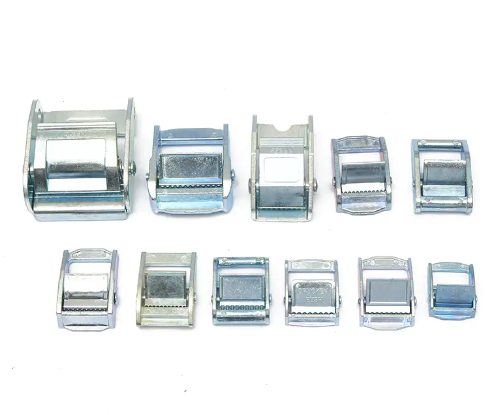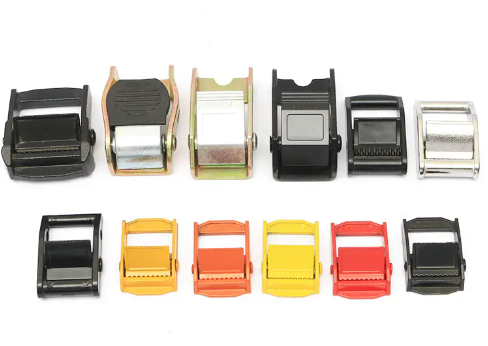No.2 new District Minglun Village,Wuxiang Town,Yinzhou District
-

Tel: +86 18658447778
-

E-mail: [email protected]
-


Alloy cam buckles are a type of buckle made of alloy material, usually zinc or aluminum. It is often used for cargo securing, such as securing items to trucks, trailers, or roof racks. Alloy cam buckles are designed with a buckle mechanism that allows for easy and safe tightening of the strap.
The cam buckle is made of alloy, which brings many advantages. Alloy materials are light and strong, suitable for securing heavy objects. In addition, alloy materials are durable and corrosion-resistant, ensuring long-lasting performance even in harsh weather conditions.
Alloy cam buckles are widely used as key components in mechanical transmission, industrial automation, logistics and transportation, and are mainly used for quick locking, positioning or intermittent motion control. Due to its long-term exposure to friction, impact and cyclic loads, wear, jamming, breakage and other faults may occur during use. In order to ensure stable operation of the equipment and extend its service life, it is necessary to understand the common fault types and take correct maintenance measures.
Failure Manifestation:
Obvious signs of wear appear on the surface of the cam buckle, resulting in a decrease in locking force.
The equipment is unstable, such as inaccurate valve opening and closing, and gaps in the transmission mechanism.
Main reasons:
Long-term high-load operation: exceeding the designed load capacity, accelerating wear.
Insufficient lubrication: increased friction, resulting in rapid loss of metal surface.
Insufficient material hardness: inferior zinc alloy or unheat-treated cam buckles are prone to deformation.
Fault manifestation:
The cam buckle is slow to move, and the resistance increases during operation.
Accompanied by abnormal noise, such as "squeaking" or metal friction.
Main reasons:
Lubricant contamination: dust and metal debris are mixed into the grease, forming a grinding effect.
Foreign matter entry: dusty working environment leads to cam groove blockage.
Surface coating peeling: after the coating is damaged, the metal is in direct contact, and the friction coefficient increases.
Fault manifestation:
The cam buckle suddenly breaks and the equipment cannot operate.
Local cracks or chipping affect the overall structural strength.
Main reasons:
Material fatigue: long-term cyclic loads cause microcracks inside the metal.
Impact load: Sudden external force (such as equipment vibration, collision) causes brittle fracture.
Casting defects: Porosity, sand holes, etc. reduce material strength.
Fault manifestation:
The locking signal is abnormal, and the equipment cannot start or stop normally.
The fault indicator light is on (such as P0013 fault code, indicating a camshaft solenoid valve problem).
Main reasons:
Solenoid valve damage: coil burns or valve core is stuck.
Circuit problems: poor contact, line aging or unstable voltage.
Seal failure: oil seeps into the solenoid valve, causing short circuit or corrosion.

Regular lubrication and cleaning
Select suitable lubricants: It is recommended to use lithium-based grease under high temperature conditions to avoid the loss of low-viscosity engine oil.
Cleaning and maintenance: Regularly disassemble the cam buckle to remove sludge and metal debris to prevent secondary wear.
Lubrication cycle: Lubricate once every 3 months under normal working conditions, and shorten to 1 month under high load or dusty environment.
Material and process optimization
Prefer high-strength materials: such as Zamak 7 zinc alloy or copper-based alloy to improve wear resistance.
Surface treatment: Chrome plating, nitriding or ceramic coating can greatly extend the service life.
Avoid overload operation: Regularly check whether the load exceeds the design upper limit, and upgrade to a higher specification cam buckle if necessary.
Fault diagnosis and replacement
Wear detection: Use a micrometer to measure the thickness of the cam profile. If the wear exceeds 0.1mm, it needs to be replaced.
Solenoid valve inspection: Use a multimeter to test the resistance. The normal value is usually 10-20Ω. If it exceeds the range, it needs to be replaced.
Spare parts management: Reserve original cam buckles to avoid dimensional deviation caused by the use of inferior compatible parts.
Environmental adaptability maintenance
Dust protection: Add a dust cover or sealing ring to reduce the entry of foreign matter.
High temperature protection: Use heat-resistant coatings or ceramic composite materials to prevent high temperature deformation.
Anti-corrosion treatment: Stainless steel or surface passivation treatment is recommended for humid or corrosive environments.
Operation data monitoring: Install vibration sensors to monitor the cam buckle status in real time and warn of wear in advance.
Regular and comprehensive inspection: Perform a systematic inspection every 6 months, including structure, lubrication, electrical system, etc.
Establish maintenance files: Record each maintenance time, replacement parts and failure conditions to facilitate trend analysis.